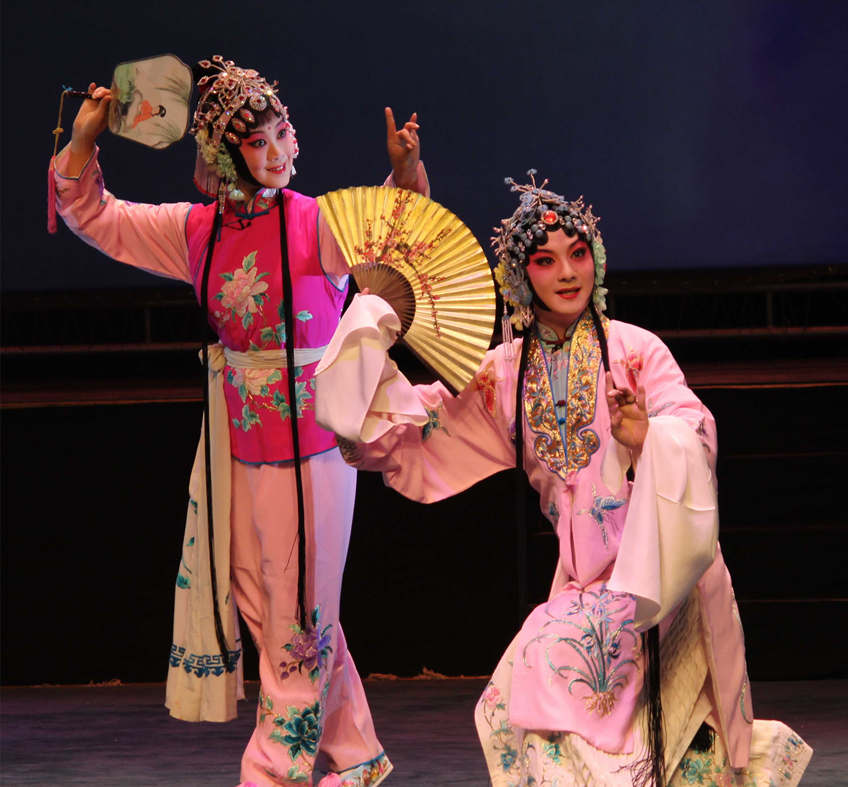Yu Opera (Henan)
Yu Opera ceaselessly inherits and reforms the form of Henan Bangzi. The abbreviation of Henan was “YU” after the founding of the People's Republic of China. So, the Henan Opera got its name “Yu Opera”. The Yu Opera is called Bang Play in the north area of Anhui province and Bangzi Play in some parts of Shandong, Jiangxi. The Yu Opera is mainly popular in the area of Yellow River and Huaihe River. Being the maximal local play, the Yu Opera has its special Yu troupe spreading in Henan, Hubei, Jiangsu, Shandong, Hebei, Beijing, Shanxi, Sichuan, Gansu, Qinghai, Xinjiang and Taiwan.

Origin
It has been difficult to textual research the origin of Henan Bangzi Play. One of versions is said that, Puzhou Bangzi Play was combined with the local folk songs and minor. Another version is said that the Yu Opera directly came from the string cord tune of Beiqux. When and where at the earliest the stage photo of Henan Bangzi Play was taken is hardly to know. According to the statement of old actor, the previous actors mostly came from Jiangmen opera school and Xumen opera school during the Qianlong period. The three superior old-type opera schools of Kaifang are Yicheng School, Gongyi School and Gongxing School. It is said that both of them have went through the Ming Dynasty and Qing Dynasty.
It is said that the Yicheng School set up the Yongan Stage in the Temple of Hephaistos of Kaifeng`s Shokokuji. The stage consists of forestage and backstage. The forestage is in charge of various odd jobs, such as tickets sale, audience receiving and tea supplying. The backstage is mainly responsible for the work of performance, like list ensuring, roles assigning, etc.
With a relative long history, Tianxing School originally was old-type opera school ran by Fengqiu. There are many famous actors in Tianxing School, such as Li Jianyun and Yan Caiyun, etc. The Liuban, Buban and Liuxingjiaban in Qi County were some famous opera school appeared after the Xinhai Revolution. Actors, such as Shuicheng, Jincheng, and Heyun were headliner at that time.
Development
Yu Opera, Beijing Opera, Yu Opear, Ping Opear and Huangmei Opear are top five operas in China. Following Beijing Opera and Yue Opear, Yu Opera is the third major opera. It is mainly epidemic in the northern area. The number of state-owned professional Yu Opera group reached 167 in 2006 according to the statistics of National Culture Department. Yu Opera is one of the local operas that hold the most professional opera group and the largest number of Yu Opera employees.
The old name of Yu Opera is "Henan Bangzi" or "Henan Gaodiao". "Yu Opera" generally means all kinds of operas in Henan Province. “Yu Opera” was referred specifically to Henan Bangzi in Kaifeng, Lanzhou and Xian until the autumn of 1947.
Henan Bangzi was renamed as "Yu Opera" after the People`s Republic of China was found. Based on the form of Henan Bangzi, Yu Opera is ceaselessly reformed and created by several generations of artist. Since then, the qualitative leap and comprehensive boom have appeared on the Yu Opera art. Henan Bangzi is the frontbody of Yu Opera. There are many differences between two plays.
In terms of tune, Yu Opera belongs to the series of Bangzi tune. Yu Opera can divides into five main genres. They are Xiangfu tone, Yudong tone, Yuxi tone, Shahe tone and the Modern Genre. The Modern Genre was formed by comprehensively absorbing and reforming other genres of Yu Opera, applying the scientific pronounce, and blending the elements of other operas after the People's Republic of China was found. Yu Opera was listed in the first national nonmaterial cultural heritage list with the approval of the state council in May 20, 2006.